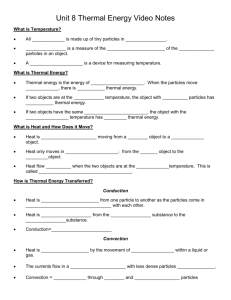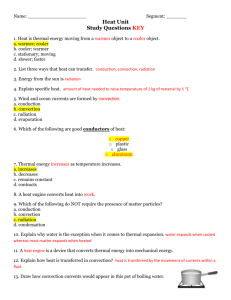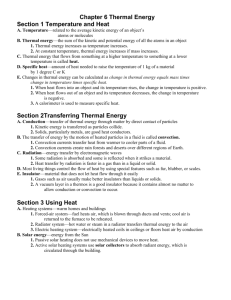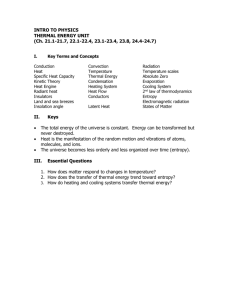Thermal energy Atoms and molecules in matter are in constant
advertisement
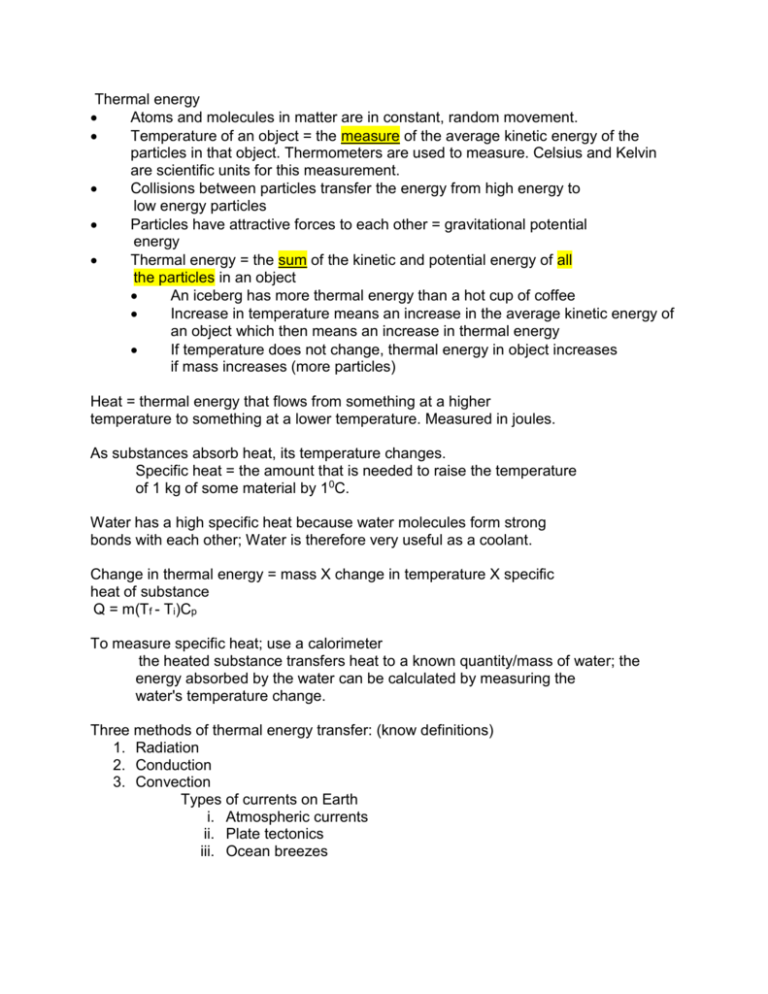
Thermal energy Atoms and molecules in matter are in constant, random movement. Temperature of an object = the measure of the average kinetic energy of the particles in that object. Thermometers are used to measure. Celsius and Kelvin are scientific units for this measurement. Collisions between particles transfer the energy from high energy to low energy particles Particles have attractive forces to each other = gravitational potential energy Thermal energy = the sum of the kinetic and potential energy of all the particles in an object An iceberg has more thermal energy than a hot cup of coffee Increase in temperature means an increase in the average kinetic energy of an object which then means an increase in thermal energy If temperature does not change, thermal energy in object increases if mass increases (more particles) Heat = thermal energy that flows from something at a higher temperature to something at a lower temperature. Measured in joules. As substances absorb heat, its temperature changes. Specific heat = the amount that is needed to raise the temperature of 1 kg of some material by 10C. Water has a high specific heat because water molecules form strong bonds with each other; Water is therefore very useful as a coolant. Change in thermal energy = mass X change in temperature X specific heat of substance Q = m(Tf - Ti)Cp To measure specific heat; use a calorimeter the heated substance transfers heat to a known quantity/mass of water; the energy absorbed by the water can be calculated by measuring the water's temperature change. Three methods of thermal energy transfer: (know definitions) 1. Radiation 2. Conduction 3. Convection Types of currents on Earth i. Atmospheric currents ii. Plate tectonics iii. Ocean breezes Understand difference between conductors and insulators …between thermal expansion and contraction Heating Systems All require energy Heat transfer is slow - disadvantage Types: 1. Forced air systems - heating air by convection using fans 2. radiator system - hot water/steam heats air by conduction then warms airs through convection 3. electric heating systems - heat coils by conduction then heat air by convection Solar heating Passive - absorption of heat by materials in room Active - solar collectors/solar panels Heat engines - convert heat into work Internal combustion engine - only 25-30% heat changed to work friction of parts transferred into heat Please know the 4 steps in a four stroke engine cycle – see figure in textbook Heat movers - uses work to move heat from cooler temperature to warmer temperature Ex) refrigerator - compressors use mechanical energy to move thermal energy in the reverse of law of conservation of energy Liquid coolant -> cold gas -> absorbs thermal energy -> compressor -> increases temperature of gas -> thermal energy leaves gas into room -> gas changes to liquid -> cycle begins again Ex) air conditioners - warm air forced over tubes with coolant; air is cooled and forced back into room Heat pump - 2-way heat movers in warm weather, it works like an air conditioner in cool weather, reverse coolant is cooled and pumped outside, absorbs heat from outside air, compressed and into home, releasing heat Human coolant - sweat evaporates carrying heat away from body cooling you





